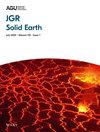Decoupling of Magnetic Fabrics From Magnetic Remanences: Insights From Migmatites in Central Tianshan, NW China
IF 3.9
2区 地球科学
Q1 GEOCHEMISTRY & GEOPHYSICS
引用次数: 0
Abstract
The coupling of magnetic fabrics and magnetic remanences is critical in interpreting paleomagnetic data. To estimate whether primary magnetic fabrics imply primary magnetic remanences, and to assess the practicability of metamorphic rocks in magnetic study, we carried out petrographic, geochronological, rock magnetic investigations, and analyses in anisotropy of magnetic susceptibility and paleomagnetism on migmatites in the Central Tianshan, NW China. Petrological observations indicate no significant dynamic recrystallization post to the migmatization. In-situ monazite U-Pb dating suggests that the migmatization happened during ∼314–297 Ma. Rock magnetic results reveal that the magnetic properties of migmatites are dominated by biotites with minor titanomagnetites. Despite the structural and compositional complexities of migmatites, a simple magnetic fabric pattern is observed with concentrated magnetic foliations and dispersed magnetic lineations. The anisotropy degree and shape parameter significantly change from leucosomes, mesosomes to melanosomes, suggesting that the magnetic fabrics should have been acquired during the migmatization. Characteristic remanent magnetization directions were isolated from a quarter of samples with anomalous shallow magnetic inclination. Combined with available geochronological and paleomagnetic results from the Central Tianshan and neighboring blocks, the magnetic remanences preserved in the migmatites were suggested to be obtained at ∼314–303 Ma, later than the acquisition of magnetic fabrics, probably due to thermal remagnetization or resulted from long-term progressive magnetization during tectonic exhumation of migmatites. This study provides an important yet rarely reported example to manifest the decoupling of magnetic fabrics from magnetic remanences. Meanwhile, migmatites are found to be operable materials for magnetic fabric and paleomagnetic studies.磁组构与剩磁的解耦:来自天山中部混合岩的启示
磁组构和剩磁的耦合是解释古地磁资料的关键。为了确定原生磁组构是否意味着原生磁残留,评价变质岩在磁学研究中的实用性,我们对天山中部混浊岩进行了岩相学、年代学、岩石磁学调查,并对磁化率和古磁学各向异性进行了分析。岩石学观察表明,岩浆岩化后无明显的动态再结晶作用。原位独居石U-Pb测年表明,杂化作用发生在~ 314-297 Ma。岩石磁学结果表明,杂岩的磁性以黑云母为主,少量钛磁铁矿。混杂岩的结构和组成复杂,但其磁性结构结构简单,磁性片理集中,磁性线纹分散。各向异性程度和形状参数在白色小体、中间小体和黑色小体之间发生了显著变化,表明磁性结构应该是在岩化过程中获得的。从四分之一的异常浅磁倾斜样品中分离出特征剩余磁化方向。结合已有的天山中部及邻近地块的年代学和古地磁结果,认为保留在混浊岩中的剩磁物产生于~ 314 ~ 303 Ma,晚于磁性织物的获取,可能是由于热再磁化或构造挖掘混浊岩过程中长期渐进磁化所致。这项研究提供了一个重要的但很少报道的例子来证明磁性织物与剩磁的解耦。同时,混杂岩是研究磁组构和古地磁的可操作材料。
本文章由计算机程序翻译,如有差异,请以英文原文为准。
求助全文
约1分钟内获得全文
求助全文
来源期刊

Journal of Geophysical Research: Solid Earth
Earth and Planetary Sciences-Geophysics
CiteScore
7.50
自引率
15.40%
发文量
559
期刊介绍:
The Journal of Geophysical Research: Solid Earth serves as the premier publication for the breadth of solid Earth geophysics including (in alphabetical order): electromagnetic methods; exploration geophysics; geodesy and gravity; geodynamics, rheology, and plate kinematics; geomagnetism and paleomagnetism; hydrogeophysics; Instruments, techniques, and models; solid Earth interactions with the cryosphere, atmosphere, oceans, and climate; marine geology and geophysics; natural and anthropogenic hazards; near surface geophysics; petrology, geochemistry, and mineralogy; planet Earth physics and chemistry; rock mechanics and deformation; seismology; tectonophysics; and volcanology.
JGR: Solid Earth has long distinguished itself as the venue for publication of Research Articles backed solidly by data and as well as presenting theoretical and numerical developments with broad applications. Research Articles published in JGR: Solid Earth have had long-term impacts in their fields.
JGR: Solid Earth provides a venue for special issues and special themes based on conferences, workshops, and community initiatives. JGR: Solid Earth also publishes Commentaries on research and emerging trends in the field; these are commissioned by the editors, and suggestion are welcome.
 求助内容:
求助内容: 应助结果提醒方式:
应助结果提醒方式:


